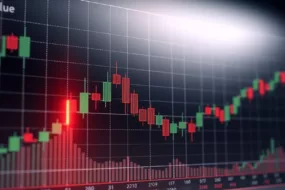
Understanding how to effectively use a Stochastic Oscillator in crypto trading can significantly enhance your trading strategy. This powerful technical analysis tool helps identify overbought and oversold conditions, aiding in decision-making.
Traders can pinpoint optimal entry and exit points by interpreting their key components and applying common strategies. However, it’s crucial to be aware of its limitations and combine it with other indicators for more accurate predictions. This guide will walk you through the essentials of utilizing a Stochastic Oscillator in the dynamic world of crypto trading.
What is a Stochastic Oscillator in Crypto Trading?
A Stochastic Oscillator is a popular technical analysis tool used in crypto trading to determine the momentum of an asset. It compares the closing price of a cryptocurrency to its price range over a specified period. This comparison helps traders identify potential overbought or oversold conditions in the market, aiding in making informed trading decisions. By understanding these market conditions, traders can optimize their entry and exit points, enhancing their overall trading strategy and potential profitability.
How Does a Stochastic Oscillator Work in Crypto Trading?
The Stochastic Oscillator operates on the principle that prices tend to close near their high in an uptrend and near their low in a downtrend. It consists of two lines: %K and %D. The %K line represents the current closing price relative to the price range over a set number of periods, while the %D line is a moving average of %K. These lines fluctuate between 0 and 100, providing a visual representation of the asset’s momentum. When combined with other technical analysis tools, the Stochastic Oscillator can offer valuable insights into market trends and potential price movements.
Key Components of a Stochastic Oscillator
- %K Line: The primary line that measures the current closing price’s position relative to the high-low range over a specified period (typically 14 days). This line is more volatile and reacts faster to price changes.
- %D Line: A 3-day simple moving average of the %K line, which serves as a signal line to identify trends and potential reversal points. This line is smoother and helps filter out market noise.
- Overbought and Oversold Levels: Typically set at 80 and 20, respectively. A reading above 80 indicates an overbought condition, while a reading below 20 indicates an oversold condition. These levels help traders gauge the market sentiment and potential reversal zones.
How to Interpret and Apply a Stochastic Oscillator in Crypto Trading?
Interpreting the Oscillator
- Overbought Condition: When the Stochastic Oscillator is above 80, it suggests that the cryptocurrency may be overbought and could be due for a price correction or pullback. This condition signals caution for potential buyers.
- Oversold Condition: When the Stochastic Oscillator is below 20, it indicates that the cryptocurrency may be oversold and could be due for a price increase or rebound. This condition signals a potential buying opportunity.
- Crossovers: A bullish signal occurs when the %K line crosses above the %D line, while a bearish signal occurs when the %K line crosses below the %D line. Crossovers provide actionable signals for traders to enter or exit positions.
Applying the Oscillator
- Traders use the Stochastic Oscillator to identify potential entry and exit points based on the overbought and oversold conditions. This helps in timing trades more effectively.
- It can be combined with other technical indicators to confirm signals and enhance trading strategies. For example, pairing it with moving averages or trend lines can improve the reliability of the signals.
Common Strategies and Limitations of a Stochastic Oscillator
Common Strategies
- Crossover Strategy: This strategy involves buying when the %K line crosses above the %D line in an oversold region (below 20) and selling when the %K line crosses below the %D line in an overbought region (above 80). The underlying principle is to capitalize on momentum shifts that occur at the extremes of the market. By focusing on these crossover points, traders can potentially enter trades at favorable points and take advantage of the expected price movements.
- Divergence Strategy: Divergence occurs when there is a discrepancy between the Stochastic Oscillator and the price action of the cryptocurrency. A bullish divergence is identified when the price makes a new low while the oscillator forms a higher low, indicating a potential upward reversal. Conversely, a bearish divergence occurs when the price makes a new high but the oscillator forms a lower high, suggesting a potential downward reversal. This strategy helps in spotting possible reversals before they manifest in the price.
Limitations
- False Signals: During strong and sustained trends, the Stochastic Oscillator may generate false signals, as prices can remain overbought or oversold for extended periods. This can lead to incorrect trading decisions if traders rely solely on the oscillator without considering other factors or indicators.
- Lagging Indicator: As a lagging indicator, the Stochastic Oscillator might not always predict price reversals accurately. The delay in its reaction to price movements can result in missed opportunities or delayed entries, affecting the timing and effectiveness of trading decisions.
- Not Effective in Strong Trends: The Stochastic Oscillator is particularly useful in range-bound or sideways markets but may struggle in strong trending environments. In trending markets, the oscillator’s readings can become skewed, and other trend-following indicators might provide more reliable signals for capturing sustained price movements.
By understanding and utilizing the Stochastic Oscillator effectively, traders can enhance their ability to identify potential buying and selling opportunities in the crypto market, while also being aware of its limitations. Combining this tool with other analysis methods can provide a more comprehensive trading strategy and improve decision-making processes.
Conclusion
Mastering the stochastic oscillator can significantly enhance your crypto trading strategy by providing valuable insights into market momentum and potential reversal points. By incorporating this tool effectively, you can identify optimal entry and exit points, improving your overall trading decisions. Staying informed and continuously refining your approach is crucial in the ever-evolving crypto market.
Embrace these techniques, and consider Mudrex as your partner in navigating the complexities of crypto trading. With Mudrex’s robust tools and resources, you’ll be well-equipped to make informed, confident investment choices. So, download the Mudrex app now and begin mastering your investments. Stay proactive, stay informed, and let Mudrex be your trusted partner in the exciting world of Crypto Trading.
FAQ Questions
What is the best way to use a stochastic oscillator?
To use the stochastic oscillator effectively, monitor readings above 80 for overbought conditions and below 20 for oversold conditions. Look for buy signals when the %K line crosses above the %D line in oversold regions, and sell signals when it crosses below in overbought regions. Confirm signals with other indicators and adjust settings based on your trading timeframe to enhance accuracy.
What is the best timeframe for a stochastic oscillator?
The best timeframe for using the stochastic oscillator largely depends on your trading style. For day trading, shorter timeframes such as 5-minute to 15-minute charts are ideal, offering frequent signals and quick trading opportunities. Swing traders often prefer 1-hour to 4-hour charts, as these provide a good balance between capturing meaningful trends and filtering out noise. For long-term trading or investing, daily or weekly charts are more suitable, as they help focus on major market trends and reduce the impact of short-term fluctuations.
What are the rules of stochastic oscillators?
The stochastic oscillator operates under these key rules –
- Overbought/Oversold Levels
- Crossovers
- Divergence
- Confirmation with Trends
By following these rules, traders can better interpret potential market reversals and trading opportunities.
How accurate is a stochastic oscillator?
The stochastic oscillator is a useful tool for identifying overbought or oversold conditions, but its accuracy can vary based on market conditions and settings. It tends to perform better in ranging markets but may produce false signals in trending markets. To enhance its reliability, it’s best used in conjunction with other indicators and confirmation methods. Adjusting settings and timeframes according to the asset and market conditions can also improve its effectiveness.





